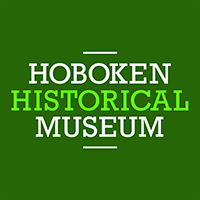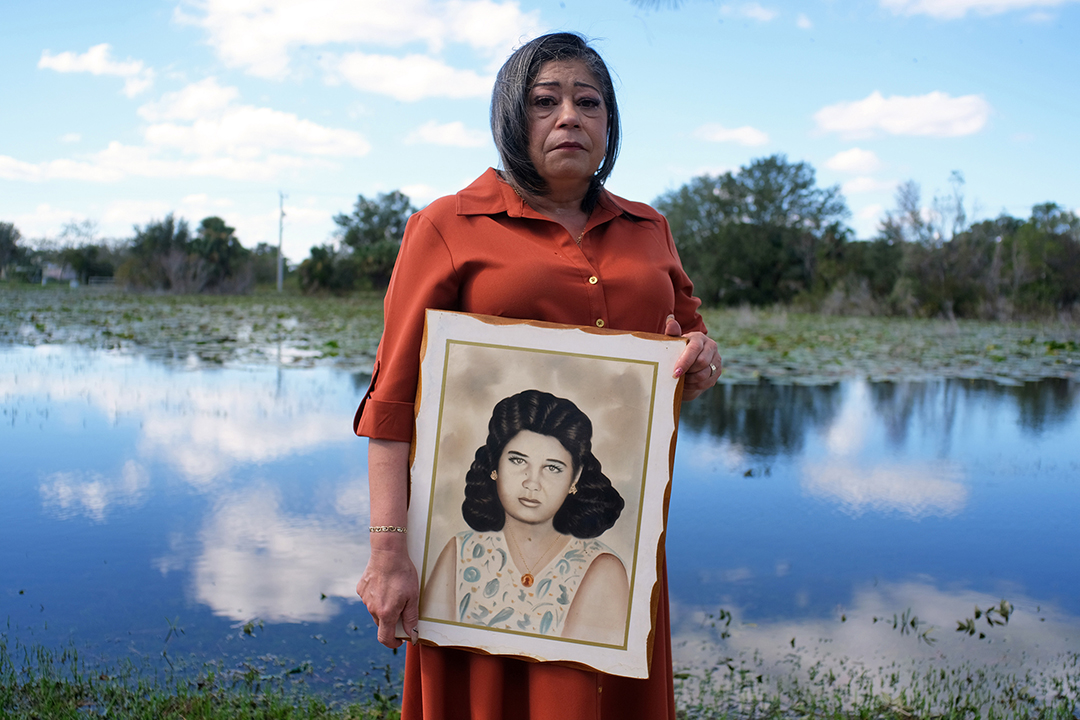Category Archives: Past Exhibition
The Heap
Sept. 24 - Nov. 5, 2023
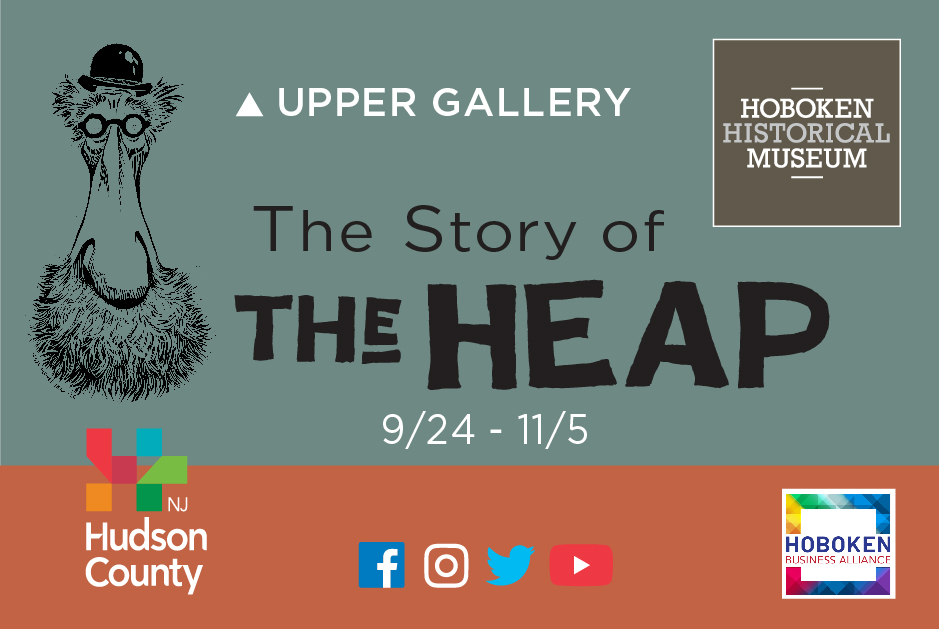
The Hoboken Historical Museum and Hoboken Business Alliance are pleased to present “The Heap,” the creative character developed by Paul Andrejco of Puppet Heap. Please be sure to check out The Heap walking through Hoboken on Friday, September 22, 2023 beginning at 3pm and journeying to the Hoboken Historical Museum. The Opening Reception for “The Heap” will take place on Sunday, September 24, 2023 from 2pm-5pm.
History
The Story of the Heap
A multimedia Exhibition
Overview
In 2012, the Hoboken Historical Museum graciously hosted an exhibit by Puppet Heap, a character design studio in town founded by designer Paul Andrejco. The exhibit was titled “Strange Neighbors: the Art & Imagination of Puppet Heap” and featured original puppets, set pieces, designs and footage from some of the company’s short films. The films take us to the town of Spudbottom, a mythical village constructed of found objects and populated by a strange mix of familiar characters from nursery rhymes, folklore, and song. We are guided through town by the voice of an unseen and less than reliable narrator. But who is this mysterious tour guide? And where is this Spudbottom, anyway?
2023
Now we’d like you to take a step back… way back… for a bird’s eye view revealing the astonishing truth: that the town of Spudbottom is actually a mountain of lost things, people, places, stories, old jokes, regrets, bad ideas, and trauma heaped upon the creaking back of an eccentric old man who, it turns out, has been muttering about the townsfolk all this time to anyone and no one. Nobody knows his name, so we simply refer to him as “The Heap.” This exhibit is not only his story, but Puppet Heap’s as well. It’s a lot like my story, and for that matter, probably a bit like yours too.
The Opening
On the opening day of the exhibit, The Heap, a larger than life size walking puppet, will lurch forth from our homebase at the Monroe Center for the Arts and slowly make its way through town, stopping to gather whatever, or whoever, it encounters along the way and adding them to its towering pack.
The Exhibit
The exhibit itself will feature a multi-media installation depicting a glimpse of the Heap later in life, after his burden had become so heavy that he has sunk halfway into the earth. Unable to move and with no one around to help him, he spends most of his time sleeping, rattling the reeds with his sonorous snoring. This attracts the attention of a curious species—part animal, part root vegetable—sprouting from the loam to marvel at this great god bearing gifts from another world.
The Closing
As the sun sets on the last day of the exhibit, the Heap will pull himself out of the “ground” and emerge from the museum. Outside, he will slowly straighten his back with a thunderous crack and rise to his full twelve foot height, freed at last from all of his earthly encumbrances. Bidding farewell to a lifetime baggage, the little children of the dirt, and all who have come to witness his transformation, he will stride forth, embracing the world once again, but this time from a new vantage point and bound for new horizons.
Statement of Purpose
As a maker of puppetry, I am constantly engaged in the art of crafting performing objects. I work with objects of narrative, whether I construct those objects or find them. All objects possess certain properties–their weight, the way they catch the light, the way they move–that in effect make them function as carriers of signals. With every puppet, every performing object, attention is needed to hear what the object has to say, what story it is carrying. Sometimes they are designed to tell those stories, sometimes the story is put upon them, and when these objects interact, through play, not only do those stories have a chance to be heard but new ones spring to life. And that is what makes it all so worthwhile. It’s a kind of spiritual practice for me. So part of the exhibit will show these puppets and performing objects, how they were designed, and how they were made.
Much of the inspiration behind Spudbottom comes from Hoboken, its architecture, its history, its people–and, frankly, all of the cool stuff I’ve found walking its streets over the decades. The more I live in this town–the changes I observe, the more I learn about its history–the more ghosts I see everywhere I look. As if all the years, all the people, the triumphs and tragedies all exist simultaneously and the community carries it all as it pushes ahead into the future. It’s as if there’s only so much space in this tiny square mile and it seems to build and build until it’s bursting at the seams and the only way out is forward. And like one can read the history of the British empire in a cup of tea, Hoboken’s history is world history. War, migration, global warming, floods, and fires, the major events of Hoboken reflect and affect those same events the world over. So, if in some small way The Heap reflects Hoboken, may it then also reflect our relationship to the rest of the world.
And it’s as much a personal allegory as well as a social one. The older I get the more I’m haunted by a non-stop party of ghosts who have overstayed their welcome. I have made a lot of mistakes, learned from some of them, while others will always remain unresolved. I have accumulated friends and loved ones, responsibilities, many questions, but few answers. And yes, stu, I have more books, pictures, toys, and sentimental objects than I can count and they travel with me from place to place. I’m plagued with a sort of magical materialism. To possess a book is to possess its knowledge, a toy its aspiration, my grandfather’s compass a sense of direction. And I have children, three of them, who I love more than anything, and my greatest honor is my legacy to them. That as I watch them grow I see what lessons I have taught them, but also what burdens I have heaped upon them. And there will come a time when I am too weak to carry it anymore, and what happens with it, for better or worse, will be up to them.
So in the end, I guess this installation is about all the things we accumulate over the course of a lifetime and what it takes to let those things go when the time comes. It’s about realizing the pile of things that define a self, or even a city, once you strip them away, is empty underneath, and how the lightness of that realization might finally set us free.
-Paul Andrejco, 2023
Patterns in the Palisades: The Pen & Ink Drawings of Peter Fiordalisi
August 13-September 17, 2023

Peter Fiordalisi was born in Union City in 1904 and had a deep connection to Hudson County, living many years in Weehawken. As a child, Peter was inspired after seeing a man painting the New York Harbor. Peter was never without his sketchbook and spent every minute he could drawing and painting. He expressed, “I paint the things I am familiar with, what I have been brought up with, the things I know best.”
Peter graduated from Mechanics Institute in New York City. Peter worked in a multitude of mediums, including watercolors, oils, wood-cut prints, pen and ink, and pencil drawings. He was profoundly influenced by his environment and frequently drew landscapes, especially the Manhattan skyline.
He received numerous accolades, including the Jersey Journal Award of Graphics in 1959 and in 1972, the Windsor & Newton Award for Watercolors and the Hudson Artist Inc Award for Oil Painting. He was a founding member and president of the Hudson County Artist Guild. Fiordalisi had exhibits in Newark Museum, the state museum in Trenton, Montclair Art Museum, Jersey City Museum, and the Elks Club in Hoboken. He was also an instructor of painting and crafts in the Adult Education Project at Memorial High School in West New York.
Peter died at St. Mary Hospital in Hoboken at the age of 83. While Peter is no longer with us, his work lives on. We are very proud to present a solo exhibition of Peter’s work entitled “Patterns in the Palisades: The Pen & Ink drawings of Peter Fiordalisi,” which opens Sunday, August 13 with a reception from 2pm-5pm. Some works are on loan from Sharon Florio, while others are from the Hoboken Historical Museum collection. We look forward to elevating Peter’s special pen and ink drawings, and educating the public about this marvelous artist and son of Hudson County.
“Hoboken: Studio and Garden, Paintings by Bill Curran”
May 21, 2023 – June 25, 2023
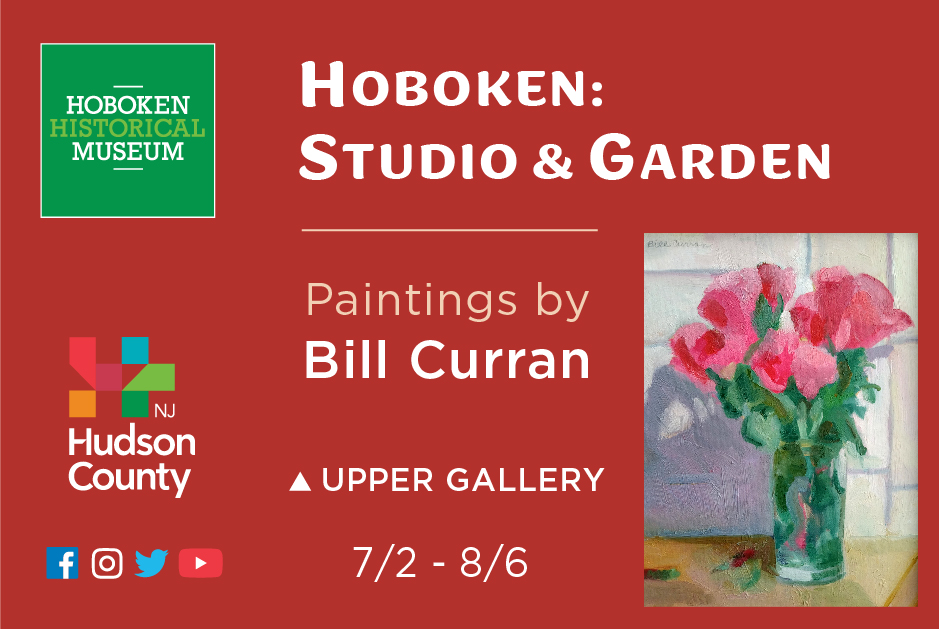
“Hoboken: Studio & Garden, Paintings by Bill Curran” opened in our Upper Gallery on Sunday, July 2 with a reception from 2-5pm. To get us ready for the exhibition, Bill Curran was interviewed by Maggie Hinders for an online Artist Talk on Thursday, June 29 at 7pm. The exhibit will run until Sunday, August 6.
If you have ever visited the Hoboken Historical Museum, there is a good chance that you have been greeted by our Museum Associate, Bill Curran. Bill has worked for the museum for 16 years now. In addition to his work at HHM, Bill is an extraordinary painter. In 2019, Bill’s creative process was featured in a documentary short entitled “What Aristotle Said” by David Gross, and was shown at the Thomas Edison Film Festival at the National Gallery in Washington, D.C. His favorite medium is oil on canvas. He also paints oil on wood. Bill shares that the Muse whispers to him and instructs him to paint. He does his best to immediately oblige and is deeply grateful for the inspiration.
“Hoboken: Studio & Garden, Paintings by Bill Curran” is Bill’s fifth show exhibited at HHM. This exhibit is bright and vibrant, and includes still lifes. But, Bill displays a great diversity in his work and also communed with nature by engaging in plein air painting (painting in the outdoors.) For three years, Bill met on a weekly basis with fellow artist Maggie Hinders, rain or shine, and painted at the community garden located at 6th and Garden Street in Hoboken.
The paintings from this show have never been exhibited before. Bill cites the American painter, Lois Dodd, as a great inspiration. Bill shares a deep reflection about Hoboken and how the city impacts his work. “In one moment, I see a rosebush, or a beautiful building. The next minute, they are torn down and gone. What I’m trying to do is capture the beauty that is right in front of us before it disappears.”
Bill, thank you for your inspiring work! We look forward to sharing Bill’s work with our community.
Instagram: @billcurranart
Website: billcurran.net
COMMUTE: photographs by Anthony Jannelli
May 21, 2023 – June 25, 2023
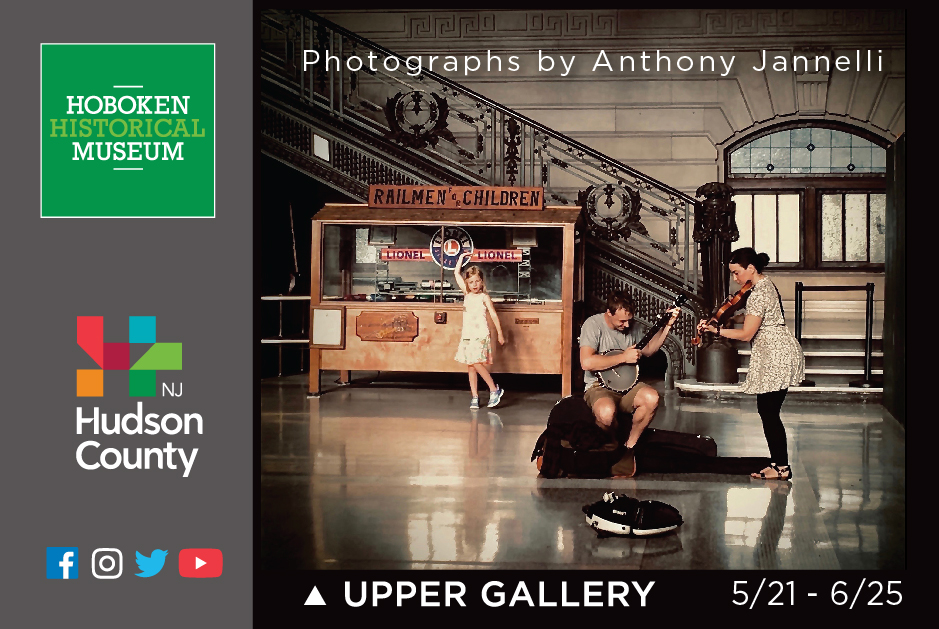
“COMMUTE: photographs by Anthony Jannelli” opened in our Upper Gallery on Sunday, May 21 with a reception from 2-5pm. Jannelli joined Museum Director Bob Foster for an online Artist Talk Friday, May 19 at 7pm. It can be viewed below, as well as on Facebook. The exhibit runs until Sunday, June 25. For more info, visit Anthony’s website here.
Born and raised in Summit, New Jersey, Anthony Jannelli has worked as a cinematographer in the motion picture industry for 4 decades. He has worked on feature films, short films, television series and commercials with Martin Scorsese, Jonathan Demme, Robert Benton, Mike Nichols, Jodie Foster, Tim Robbins, Penny Marshall, and many others. Additionally, Anthony has filmed television promos and music videos with The Rolling Stones, Paul McCartney, Michael Jackson, Aretha Franklin, Bruce Springsteen, Neil Young, Talking Heads, and Laurie Anderson. He photographed the pilot and the full first season of Law & Order Special Victims Unit.
His first professional job was as an assistant cameraman for John Lennon and The Plastic Ono Band’s One to One concert at Madison Square Garden in 1972. His first feature as a director of photography, Longtime Companion, won the 1991 Audience Award at the Sundance Film Festival. In 2008 he directed the short film Five Years of Forever, which went on to win an Accolade Award for Excellence in Direction. Currently, Tony is cinematographer on the Untitled Tom Wilson Project, about renowned record producer Tom Wilson, which is being directed by Marshall Crenshaw.
A member of the International Cinematographers Guild and the Directors Guild of America, he has been an instructor at the Sundance Filmmakers Workshop and the Maine Photographic Workshops for Film and Television.
A professor of cinematography at NYU Tisch School of the Arts/Graduate Film Program since 2002, he has served as Head of the Cinematography Department 2005-2023 and as Head of Graduate Studies 2007-2008. He also taught cinematography at NYU’s Tisch Asia (Singapore) in 2009. He has been a Hoboken resident since 2010.
In 2018, Anthony began to shoot one photograph a day during his daily commute from Hoboken to NYU using only his iPhone. He shares: “What at first was an exercise in observation, I soon learned that capturing everyday life could also be a bridge to love, empathy, and sometimes humor.” In 2021, Anthony published a book entitled “COMMUTE,” a collection of street photography taken in and around Hoboken and Greenwich Village. The Hoboken Historical Museum is pleased to exhibit these extraordinary photographs in the Upper Gallery.
The exhibit is supported by a block grant from the State/County Partnership program for the Arts, administered by the Hudson County Division of Cultural and Heritage Affairs.
Shipyard Marina: watercolors by Patrick Neill
April 8, 2023 – May 14, 2023

“Shipyard Marina: watercolors by Patrick Neill,” opens in our Upper Gallery on Saturday, April 8 with a reception from 2-5pm. Patrick joined Museum Director Bob Foster for an online Artist Talk Thursday, April 6 at 7pm. It was livestreamed on YouTube here and Facebook here. The exhibit runs until Sunday, May 14.
We’re overjoyed to welcome Patrick and his beautiful, deep watercolors to our Upper Gallery. Patrick was born in 1943! He began art lessons at a young age, so he has about 70 (!) years experience seeing, drawing and painting. It’s rare for the Museum to present the work of an artist with such a history creating, who has been exhibiting decades. Professionally, he worked for 18 years as a union carpenter and two years as the foreman of the carpenter shop at The Metropolitan Museum of Art. He’s built mock-ups for industrial designers at Henry Dreyfuss Associates and served four years in the US Air Force. After a lifetime of working, and also creating art, he has found his sure footing as a painter in retirement. He says, “One cannot be a painter part time.” To see more of his work on Instagram, just click here. Welcome, Patrick! Patrick told us about his whole life’s journey so far, and we’re so pleased to share it below. What a life! Have a read.
I was born on May 29, 1943 in Baltimore, Maryland, and raised in McPherson and Emporia in Kansas. I took art lessons from Mrs. Pool, a retired teacher, whom I had met at a local craft fair when I was 11 or 12. I got a boy scout art merit badge with work that I had done at Mrs. Pool’s. The merit badge counselor, Norman Eppink, was the chairman of the art department at the local college. He suggested that I draw with a large stick of charcoal like the charred end of a stick.
My family and I went to the Nelson Art Gallery in Kansas City to view the showing of the Chrysler Collection. I was impressed by a large van Dyck and a drawing by Juan Gris. Nell Blaine told me that she had been impressed also by the Chrysler Collection when she was a girl.
While in high school I worked at the local stock yards in the summer hauling hay: loading and unloading 4 truckloads of 4 – 5 tons each with a partner. I started drawing in connection with zoology lab in college after a four-year hiatus. My academic performance was lacking. After a year back home, I moved to Portland, OR. I enrolled in painting and watercolor classes at Portland State College. The watercolor class was disappointing. I visited the art museum in Portland. I worked at the Albina Freight Yards as a class 2 loader. Occasionally I was assigned to unload barges of 50# sacks of lime and 100# bags of starch for the paper mills. I enlisted in the Air Force. I was stationed at Williams AFB, AR, for the next 3 years and 9 months. I enrolled in night classes in painting and life drawing at Arizona State University, which was near Willams AF base. I took several semesters of life drawing at ASU. Eugene Grigsby was the teacher in life drawing and Mr. Wagner in painting.
I moved back to Emporia, Kansas after my discharge from the Air Force. I enrolled in Emporia State College. Life drawing was added to the curriculum at my instigation. My senior year, I persuaded Norman Eppink to supervise me in a seminar. He encouraged me to do tight drawings with charcoal pencils, ala Richard Estes. I graduated with a double major, in Art and English. I worked for Didde-Glaser, a graphic arts manufacturer, while in college, full-time in summers and 20hrs/week during the school year. My designation was that of stock clerk but I drove a truck and fork lift mostly.
While I was in the Air Force, I read an essay by Phillip Guston in the Art News, which had been a lecture at the New York Studio School of Drawing Painting and Sculpture. After I graduated I applied to the Studio School and I took a bus to New York for the interview and was accepted. The emphasis of the school was studio work exclusively. The first semester I did life drawing in the morning and painting in the afternoon. I exchanged life drawing for sculpture in the second semester. I was granted a full Scholarship. As part of the work for the scholarship, I rebuilt the iron steps in the small court yard of the town house.
The school rented a bus and students and some faculty went to the Barnes Foundation in Merion, PA. I didn’t realize that it was such a privilege. I must have thought the museum was just always in waiting for students to spend a day leisurely wandering through the various rooms viewing the paintings. My opinions regarding the relationship between different artists and periods of painting were confirmed. My interactions with Leland Bell, George Spaventa and Esteban Vicente were particularly important to me. Mercedes, the dean, knew many people in the art world and attracted speakers such Buckminster Fuller, Phillip Guston and Meyer Shapiro for the lectures and informal talks with Willem De Kooning and George McNeil for instance.
During my time at the Studio School I helped Leland Bell prepare for his upcoming spring show by making canvas stretchers for him. He showed me a stretcher that he’d bought in France. The superintendent, Mr. Bohn, at St. Francis Xavier on West 16th St., where I was a night watchman, permitted me to use the shop there to make French-like stretchers for Leland Bell’s show.
I didn’t return to the studio school after one year believing that I had to go my own way. Leland Bell with whom I maintained a relationship for several years after the studio school, encouraged me to go to the Kansas City Art Institute where he occasionally taught. Had I done so my prospects as an artist may have been enhanced with an MFA. Myself and two other Studio School students renovated a club in East Hampton, NY, for Mercedes Matter’s son. With money from that job I bought machines to start making French-style stretchers. Through Leland Bell I met other artists: Robert DeNiro, Sr, Paul Resika, Nell Blaine, Warren Brandt and Ilya Bolotowsky whom I supplied with stretchers for several years. I made stretchers for painting restorers/conservators also, principally the Paul Moro studio. Many masterpieces of painting have been mounted on stretchers that I made.
In 1980, I returned to New York City after a year working in Kansas. I worked at Julius Lowy and Shar-Sisto Inc., experts in period framing, making stretchers for a year. Afterwards I built mock ups for Henry Dreyfus Assoc., an industrial design company, for a couple of years. I was foreman of the carpenter shop at the Metropolitan Museum of Art for two years. After the Met job, I was a union carpenter until I retired in 2003.
While at the Met I began going regularly to the Project of Living Artists on Green Street for the life drawing sessions and continued going there and occasionally to the Spring Street Studio and Art Students League; wherever I could draw from models. I stopped going a few years ago. While I worked at the Met I also began to make regular use of sketchbooks which I continue to do. With life drawing and sketchbooks, I had hoped to keep my hand in as an artist until I retired.
While this may have been helpful to me as an artist when I retired, I learned that it would be another 10 years before my work showed consistent quality in painting. This shift can be observed in my sketchbooks. My sketchbook entries show significant improvement beginning in 2013.
One cannot be a painter part time.
The exhibit is supported by a block grant from the State/County Partnership program for the Arts, administered by the Hudson County Division of Cultural and Heritage Affairs.
“From a Yuppie’s Typewriter” – Poems by Pierce Logan
February 26, 2022 – April 2, 2022

In conjunction with our Main Gallery exhibit, “The Fires: Hoboken 1978-1982,” the Museum is pleased to present the work of Pierce Logan of QWERT Poetry in our new Upper Gallery exhibit, “From a Yuppie’s Typewriter,” from February 26 through Sunday, April 2.
With this one-of-a-kind batch of seventeen poems, Pierce aims to capture the hearts and minds of Hobokenites past and present. “From a Yuppie’s Typewriter” showcases tidbits of the city’s history through the lens of polemic personal opinions and hot topics. It takes inspiration from the 1987 book edited by Joseph Barry and John Derevlany, ‘Yuppies Invade my Home at Dinnertime,’ which was a compilation of Hoboken-resident-submitted letters to The Hoboken Reporter, while giving contemporary citizens an opportunity to express thoughts on current issues surrounding the city and cities like Hoboken.
Pierce says, “This is my biggest project yet. As the city contends with gentrification, battles between “B&Rs” and “Yuppies”, the questions of identity and belonging are ever-present and always unanswered, and turn out to be byproducts of all contemporaries of their time. The work aims to reflect the voices of the authors’ and as such, poems range from biting sarcasm to calls for justice, to contradictory and light-hearted.”
The Museum is thrilled to welcome Event Typewriter Poet Pierce Logan and his original, topical and engaging exhibit to our Upper Gallery.
On Friday, February 24 at 6pm, Pierce was interviewed by the Museum’s Poet-in-Residence Danny Shot in an online-only Artist Talk that was livestreamed on the Museum’s YouTube channel and Facebook page.
Additionally, on March 26th Pierce will bring typewriters into the Museum and visitors will be able to compose their own “letters” that will then be added to the exhibit. He will guide attendees in how to use these under-appreciated, antiquated machines. These sessions allow attendees to pay homage to the past, and the pieces that they create will be displayed, and become part of this dynamic exhibit. There will also be a live reading of the poems.
Pierce has recorded audio introductions for and readings of each of the poems, which are accessible to visitors of the Upper Gallery by scanning QR codes. The audio is also available here:
| Introduction – Welcome to Mile Square City | Chapter 1 – The Butcher Is Dead | Chapter 2 – Eating Dog Eat Dog | Chapter 3 – What the #$&% is a Yuppie? |
| Chapter 4 – Photographs of Residents | Chapter 5 – Hoboken Meets Reagan and The Rest of The World | Chapter 6 – Always a Pleasure | Chapter 7 – Dinks Like Drinks |
| Chapter 8 – FEAST! | Chapter 9 – The Italians | Chapter 10 – Class Warfare | Chapter 11 – YODAs & Puppies |
| Chapter 12 #1 – If The Reebok Fits | Chapter 12 #2 – Much Ado about Curtains | Chapter 13 – The Riots No One Writes about, or, Hopaghan Hackingh | Chapter 14 – Dumps and Stevens |
| Epilogue |
Pierce Logan is a writer, English teacher, and poet based in New Jersey. Pierce began QWERT Poetry, a custom typewriter commissions company, in 2015 and has since composed hundreds of original poems on a typewriter for strangers. The mission of QWERT Poetry began as an effort to gain exposure with his writing and later turned into an opportunity to inspire more celebration into our lives by offering the space to commission something personal. Pierce has authored several books including QWERT Poetry’s Favorite Requests, Volume I, publishing several original scans of requested poems, Oblong and Bedrock, early poetry collections, and “HOUSE OF PAIN”, an epic poem which will be reformatted into a theatrical production in 2023 and 2024. Find published work in FATHERFATHER Magazine, The Spectre Literary Review Magazine, Writer’s Pocket, SOUP CAN Magazine, and Free The Verse. Press includes Tap Into Hoboken, podcast interview at The Life Eclectic, and the artist’s first solo exhibition at Green Hive Atelier in Union City, New Jersey with eight original framed pieces October 2022-December 2022.
QWERT Poetry is a poetry experience. In the age of “immersive experiences” QWERT stands out. You will take home a custom gift composed on a typewriter that will melt your heart, bring you to tears, or leave you overjoyed — that’s the goal. Begin with a subject in mind; Pierce will ask you a series of questions to dig deeper, unlock the reason for your request (like going to the doctor), type it out for 5ish minutes, stamp it with wax in the color of your choice, then read it to you, offering a frame.
The exhibit is supported by a block grant from the State/County Partnership program for the Arts, administered by the Hudson County Division of Cultural and Heritage Affairs.
“(UN)ERASED” by Christopher López
September 11, 2022 – October 20, 2022
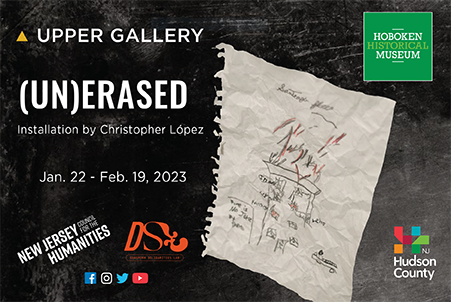
In conjunction with our Main Gallery exhibit, “The Fires: Hoboken 1978-1982,” we are proud to present an accompanying installation by Christopher López. (UN)ERASED, our new Upper Gallery exhibit, has its opening reception Sunday, September 22 from 2 – 5pm. This installation received support from the Hudson County Office of Cultural and Heritage Affairs and will run until Sunday, February 19, 2023.
In this installation, photo-based artist Christopher López utilizes both contemporary and appropriated archival imagery to construct a visual dialogue through collage that evidences the human toll that arson played on mostly migrant communities during Hoboken’s gentrification. “This is the first time that I am exhibiting this new work. The Hoboken Historical Museum is the most important space for this work to be experienced. These photographs and stories belong here. I’m honored to share them with this community.”
When asked how he uses his skills as both an artist and a historian in this exhibit, López answered, “The gentrification of cities thrives on the erasure of its pre-existing communities. As a historian, my purpose is to fight against that in whatever way I can. My goal is to create a compendium of this history by using every resource made available to me. The people’s names, their likenesses, their stories have been buried, and run the risk of being permanently erased. My work aims to change that.”
When asked how exactly stories are erased, López answered, “Stories have the potential to be erased depending on who is driving the narrative. In gentrified cities like Hoboken, it happens through this self-anointed position of pioneerism and the cultural appropriation of urban spaces. In its perversity, it picks and chooses the things it likes and discards the rest. The rest, in this case, are actual human lives. Gentrified cities are very cookie cutter and are not actually designed by people, but rather, by developers and banks to meet the demands of an upper tier consumerism. The palpable sense of community is no longer present. The creation of this absence is exacting in its design and predominant function, which is to rebrand a city’s already existing cultural capital and replace it with a newer fiscal capital.”
Our Upper Gallery exhibit, “(UN)ERASED” is a precious opportunity to view tragic pieces of our shared history through this artist’s compassionate, discerning perspective. It’s also a key companion piece to our Main Gallery Exhibit, and we urge everyone to experience this installation before it ends its run on Sunday, February 19.
Christopher López (b.1984), was born in The Bronx and was raised between New York and Northern New Jersey. He has been working as a visual artist since 2005. To date, many of his works have been made on the island of Puerto Rico. Often by exploring diminishing histories, his photographs celebrate the richness of culture as well as portray the complexities of identity both on and off the island. His work was most notably exhibited in the exhibition, “Caribbean; Crossroads of the World” which spanned three museums in New York City and showcased over 100 years of Caribbean art from the region’s most prominent artists.
Christopher has been awarded fellowships at The Laundromat Project and The Diaspora Solidarities Lab. He is a current member of Diversify Photo, an initiative started to diversify the photography industry and has given lectures at Barnard College and Cornell University among others. His artworks are currently in the permanent collections of El Museo Del Barrio, The World Trade Center Memorial Museum, and The Smithsonian National Portrait Gallery.
The exhibit is supported by a block grant from the State/County Partnership program for the Arts, administered by the Hudson County Division of Cultural and Heritage Affairs.
The Fires: Hoboken 1978-1982
January 22, 2023
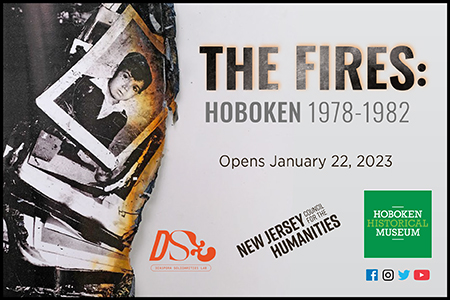
We are proud to announce two exhibits by photo-based artist and arts educator, Christopher López. “The Fires: Hoboken 1978-1982” shines a light on horrific events from Hoboken’s early period of gentrification. This visual and oral history project will be on display in our Main Gallery through the summer, closing date to be announced. A companion installation “(UN)ERASED” will be on display in our Upper Gallery through Sunday, February 19. On Friday, January 20 at 7pm, López was interviewed on the Museum’s YouTube channel by Museum Director Bob Foster as part of our ongoing “Artist Talks” series. Click here to view, or simply scroll down to the “Artist Talk” link below. Scroll down to see the Sunday afternoon series of special EXHIBIT EVENTS that will provide additional data, perspective and context. Scroll down for links to SELECT ELEMENTS FROM THE EXHIBIT AVAILABLE ONLINE
In the late 70s, as Hoboken became more desirable to ‘young urban professionals’ who could afford to pay higher rents, there was a plague of fires in buildings that housed mostly Puerto Rican families. Nearly every fire, investigators determined, was the result of arson. This exhibit addresses many factors at play at that time. It highlights the fifty-six people, mostly children, who were killed and the eight thousand that were left homeless. The exhibit also features QR codes which allow visitors to hear survivors tell their own stories.
López says, “Gentrification remains a critical subject in small cities like Hoboken as well as on a global scale creating an epidemic of displacement and violence alongside ‘urban renewal’. The visceral ramifications of gentrification are evidenced throughout the living history of Hoboken. This project is a work in progress and will be the first to offer a thorough analysis of the intersecting histories that transformed the city from a working-class community to one of the most expensive and exclusive cities in New Jersey.”
López’s work is augmented by the contributions of humanities scholars Yomaira Figueroa-Vásquez, Ph.D. and Dylan Gottlieb, Ph.D. Dr. Figueroa-Vásquez is a co-creator of The Diaspora Solidarities Lab, a multi-institutional Black feminist partnership that supports solidarity work in Black and Ethnic Studies. López says, “Yomaira grew up in Hoboken. We connected because of our shared interest in this history and the toll it took on the vast Puerto Rican community here. Yomaira is writing a book slated for release in 2024, and she will be dedicating a chapter to the fires. I’m honored to be working with her.” Of Dylan Gottlieb, López says, “He wrote a very compelling essay on the history of the fires that was tremendously influential to me and really sparked all of the work you see today. But besides his essay, there is no history. My work aims to change that.”
The companion installation “(UN)ERASED,” uses both contemporary and appropriated archival imagery to construct a visual dialogue through collage that evidences the human toll that arson played on mostly migrant communities during Hoboken’s gentrification. López says, “Stories have the potential to be erased depending on who is driving the narrative. In gentrified cities like Hoboken, it happens through this self-anointed position of pioneerism and the cultural appropriation of urban spaces. In its perversity, it picks and chooses the things it likes and discards the rest. The rest, in this case, are actual human lives. Gentrified cities are very cookie cutter and are not actually designed by people, but rather, by developers and banks to meet the demands of an upper tier consumerism. The palpable sense of community is no longer present. The creation of this absence is exacting in its design and predominant function, which is to rebrand a city’s already existing cultural capital and replace it with a newer fiscal capital.”
Christopher López (b.1984), was born in The Bronx and was raised between New York and Northern New Jersey. He has been working as a visual artist since 2005. To date, many of his works have been made on the island of Puerto Rico. Often by exploring diminishing histories, his photographs celebrate the richness of culture as well as portray the complexities of identity both on and off the island. His work was most notably exhibited in the exhibition, “Caribbean; Crossroads of the World” which spanned three museums in New York City and showcased over 100 years of Caribbean art from the region’s most prominent artists.
Christopher has been awarded fellowships at The Laundromat Project and The Diaspora Solidarities Lab. He is a current member of Diversify Photo, an initiative started to diversify the photography industry and has given lectures at Barnard College and Cornell University among others. His artworks are currently in the permanent collections of El Museo Del Barrio, The World Trade Center Memorial Museum, and The Smithsonian National Portrait Gallery.
EXHIBIT EVENTS take place on Sunday at 4pm, and are free unless otherwise noted
February 19: “Yuppies Invade My House at Dinnertime” Reading of a hybrid /documentary play by Mile Square Theatre’s playwright-in-residence Joseph Gallo. Nearly every word is taken verbatim from primary source documents of the time. Dylan Gottlieb, PhD, Historian of American Cities and Capitalism leads the talkback. Tickets are $20, available here.
March 5: Pastor Elaine Thomas, Rector of All Saints Episcopal Parish. Thomas will speak on her doctoral dissertation, “The Mile Square Cathedral: The Church as Community Healer.”
March 12: Janet Ayala, survivor of the fire at the Pintor Hotel which killed 13 people, including 7 children. Exhibit curator Christopher López will be present.
March 26: Bill Bayer, photographer for the Hudson Dispatch newspaper during the time of the fires.
April 2: “The Fires and the founding of The Hoboken Shelter”. Mark Singleton in conversation with the Museum’s Collections Manager Rand Hoppe: Mark grew up in Hoboken and was board president of the Hoboken Shelter for many years. Rand is a long-standing Shelter board member.
April 16: Yomaira C. Figueroa-Vásquez, Ph.D. Hoboken-born consultant on the exhibit. Award-winning writer, scholar, and associate professor of afro-diaspora studies at Michigan State University.
SELECT ELEMENTS FROM THE EXHIBIT AVAILABLE ONLINE
The Introduction – The Hoboken Fires: A Call to Witness, by Yomaira C. Figueroa-Vásquez
Text from the Timeline, based on Hoboken Is Burning: Yuppies, Arson, and Displacement in the Postindustrial City by Dylan Gottlieb
Click on the portraits below to be taken to a YouTube video where you can hear each person’s Oral History recording
“The Fires: Hoboken 1978-1982” was produced by Christopher López, in partnership with the Hoboken Historical Museum.
These exhibits were made possible with funds from The New Jersey Council for the Humanities, The Diaspora Solidarities Lab, and with support from a block grant from the State/County Partnership program for the Arts, administered by the Hudson County Division of Cultural and Heritage Affairs.
“Making the Sinatra Bust” by Chris Dahlberg
September 11, 2022 – October 20, 2022
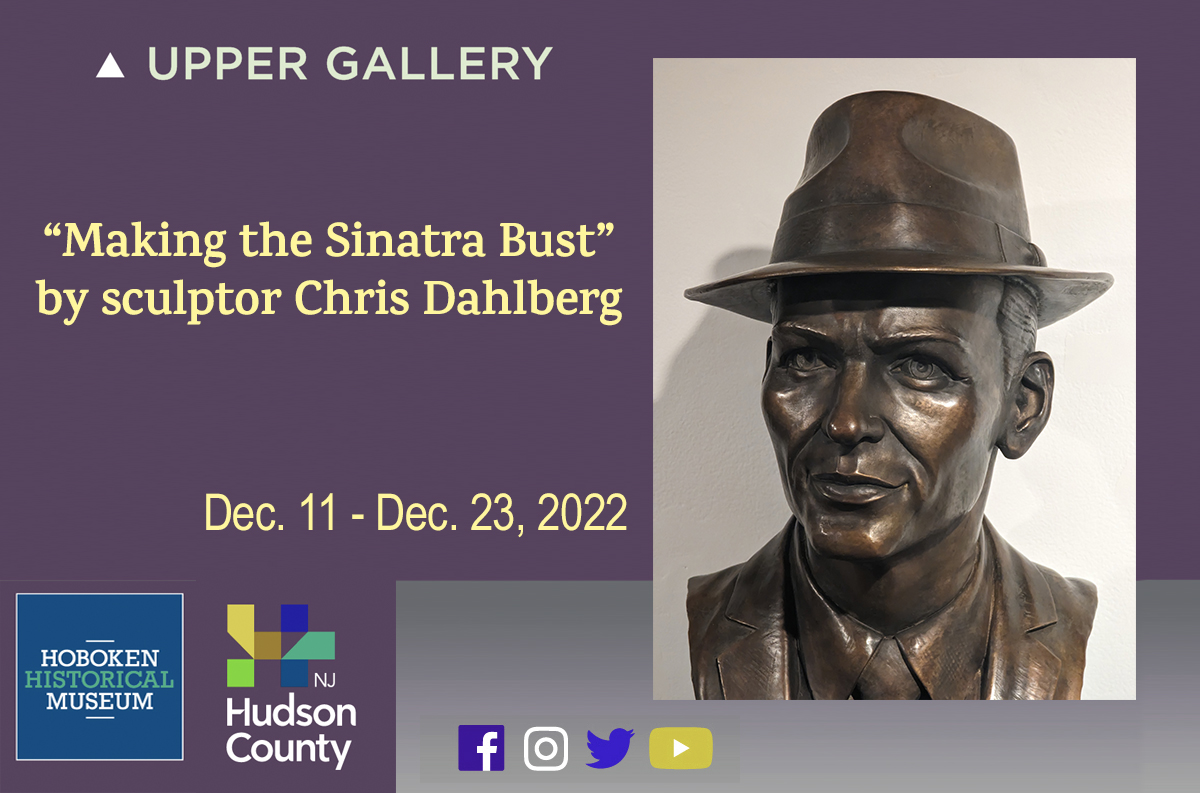
On Sunday, December 11, we kicked off the House Tour with the unveiling of our new bronze bust of Sinatra by master sculptor Chris Dahlberg. The bust can be viewed until Friday, December 23 in our Upper Gallery where you can also view large scale prints depicting various stages of the complex and fascinating production process. The bust was made possible by an anonymous gift from a Museum supporter, to whom we are extremely grateful. When the Museum re-opens on Sunday, January 22, the bust can be viewed at its new permanent home in the Sinatra lounge.
Chris talked with Bob Foster on Friday December 16 about the bust and his work in general. Click here to view on YouTube.
Chris Dahlberg was born and raised in Madison, Connecticut and attended Lyme Academy of Fine Arts with a concentration in traditional figurative sculpture. He later attended Parsons School of Design and received his MFA. Chris has created numerous bronze sculptures for private collectors and public spaces. One of his notable pieces is a bronze bust of James Madison. He was commissioned by both Madison NJ and Madison CT, where each sculpture resides in their town centers.
Chris entered into the toy and entertainment industry in the early 90’s where he utilized his traditional sculpting techniques in the commercial field. He designed and created action figures and collectible statues for Mattel as well as Harry Potter, Masters of the Universe, DC Comics and numerous other movie related themes. He currently owns and operates Lone Horsemen Toy Design and works with multiple toy and entertainment companies.
Chris moved to Hoboken in 2023 where he now works and resides. He continues to work within the commercial field while maintaining his passion for traditional bronze sculpture. See more of his gorgeous work on Instagram here.
Unclassical: Contemporary Still Lifes by Deborah Pohl
September 11, 2022 – October 20, 2022
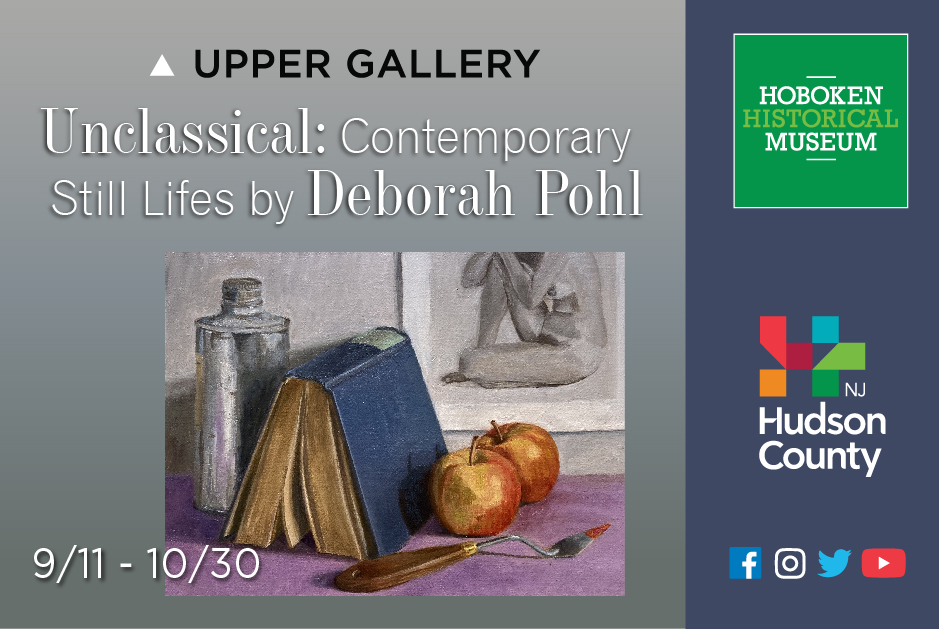
We are thrilled to present recent paintings by a longtime Hoboken resident. Our new Upper Gallery exhibit, “Unclassical: Contemporary Still Lifes by Deborah Pohl” has its opening reception Sunday, September 11 from 2 – 5pm. The show’s run has been extended until until Sunday, November 27.
Deborah Pohl has been a proud and involved Hoboken artist since 1996. Deborah’s connection with the Hoboken artist community began with figure drawing classes at the Liquid Lounge. She later started working out of an art studio in the Neumann Leather Building and has been displaying her work through the years in the city’s local art spaces and citywide arts tours.
Deborah was recently awarded a 2022 Fellowship for painting from the New Jersey State Council on the Arts. Her numerous exhibitions include a solo show at the Trenton City Museum (reviewed by the NY Times) and the “Re-emergence” exhibit currently at the New Jersey State Museum.
In her words, “My paintings occupy the category of still life while working against the genre’s expectations by presenting objects in unfamiliar and surprising compositions. Working solely from real life, I explore light and color as I set up each painting’s composition. The objects themselves are distinctive: Classic still life objects, like fruit and drapery, are combined with overlooked and often discarded relics of our everyday lives. I use traditional oil painting methods in order to beautify the ignored and mundane. Objects speak to our senses, recalling our interactions with the world, evoking our memories. Poetic combinations of objects create new meanings. “
Deborah received a BFA from Mason Gross School of the Arts at Rutgers University. Her painting education is ongoing, as she still takes courses to hone her technique. Her educational life includes receiving a master’s degree in counseling, which also supports Deborah’s desire to create compositions that speak to our shared humanity.
The exhibit is supported by a block grant from the State/County Partnership program for the Arts, administered by the Hudson County Division of Cultural and Heritage Affairs.
